AUNTY, THE FACE OF A WAIRAU BAR MOA HUNTER WOMAN.
 |
After a full 3D scan of Aunty’s skull was completed, an “approximation” reconstruction of the face was commenced in late 2009 at the University of Western Australia, and was undertaken solely through reference to photographs and computed tomography (CT) scan data. (See: Journal of Archaeological Method and Theory · June 2012).
The study pre-supposed that the individual would have to be of Polynesian-Maori decent, which affected some choices for the final outcome. The report states:
“The surface appearance of the skin and features was accomplished in reference to over one hundred archival photographs depicting Maori women of young to mid-age and sourced from the National Library of New Zealand digital archives (http://www.natlib.govt.nz/atl) and the New Zealand Electronic Text Centre (http://www.nzetc.org), both of which were accessed during March 2010.
Constructing the surface appearance in reference to digital images involves searching for a particular facial feature that is most similar to the parameters indicated by the anthropological and morphological analyses of the skull. This serves two purposes. Firstly, identifying the presence of a pre-defined feature shape in a large number of archival photographs indicates the plausibility of such a feature occurring within individuals of similar population affinity.”
Despite this, the final appearance achieved looked decidedly non-Polynesian-Maori, which caused one correspondent (Grace McIlroy) to remark in an anthropology blog:
Wow if I hadn't read the blurb I would never have said this was in any way a Maori face! Looks as European as you can get. Actually looks a lot like my sister, Annie (we're Irish). Especially the nose. I have never seen a Maori with a nose like that. Guess these people must know what they're talking about, right?
http://dienekes.blogspot.co.nz/2010/04/aunty-600-year-old-maori-woman.html |
Rather than simply undertake an unbiased, scientific-approach analysis, devoid of preconceived notions as to which racial-ethnic grouping “Aunty” belonged, every effort was made to represent her as Maori from the very start. Despite this she looks decidedly European or similar to the Lapita People facial reconstructions. Here are a few of those:
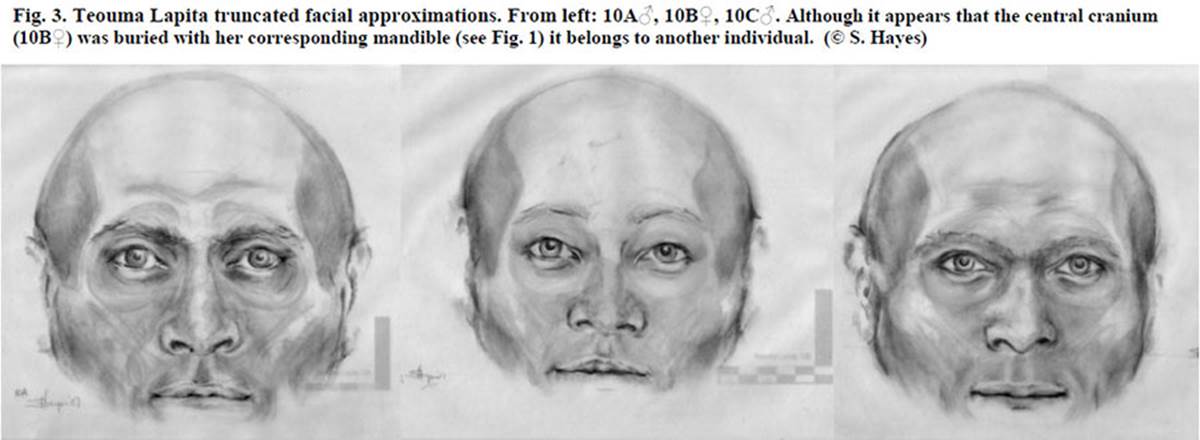
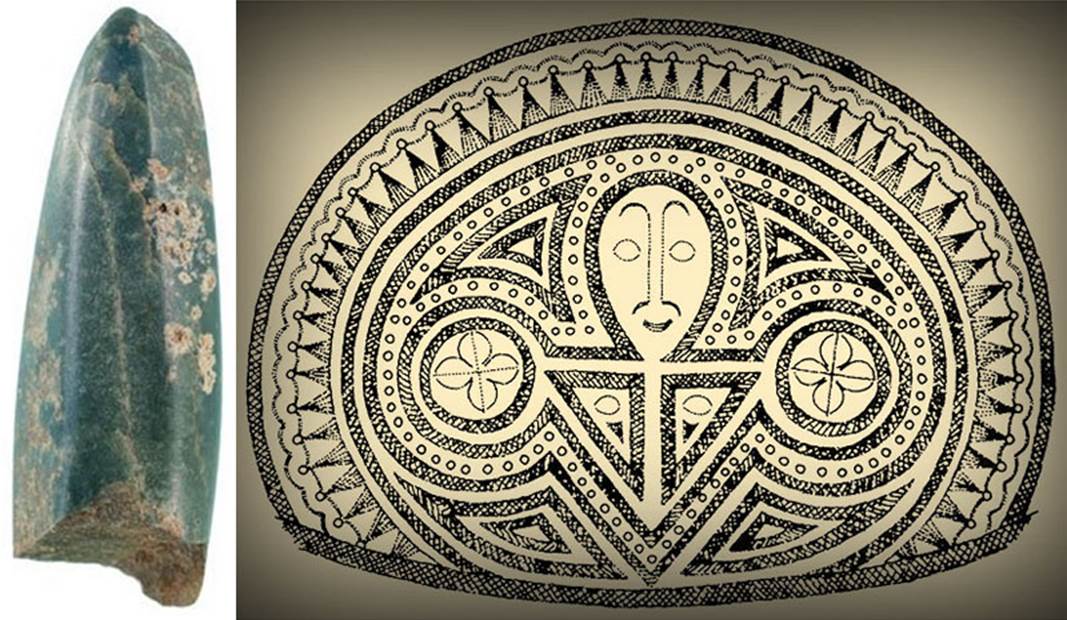
One jadeitite wood-gouge recently discovered on a coral island in Papua, New Guinea has been dated at 3300-years old and the only known region where jadeitite specimens are found to contain similar chemical properties is in Baja California Sur, Mexico. The artefact is attributed to the Lapita people, who ranged through the Pacific Ocean for millennia before the epoch of the Polynesians.
The Lapita people created ornately designed pots, covered in knop, chevron, lozenge and double spiral features which duplicated designs on the kerbstones of Knowth, Newgrange & Dowth chambered mounds or patterns found on Wessex pots of ancient England. The above design from a Lapita pot shows a Lapita face, encompassed by an Egyptian Ankh cross. The face is long, with wide eyes, small mouth clench, and a leptorrhine nose, beneath which is a moustache ... all European or Caucasoid features.
SOME REALISTIC DISCUSSION ABOUT THE GREENSTONE PENDANT FOUND AMIDST GRAVE GOODS AT WAIRAU BAR.
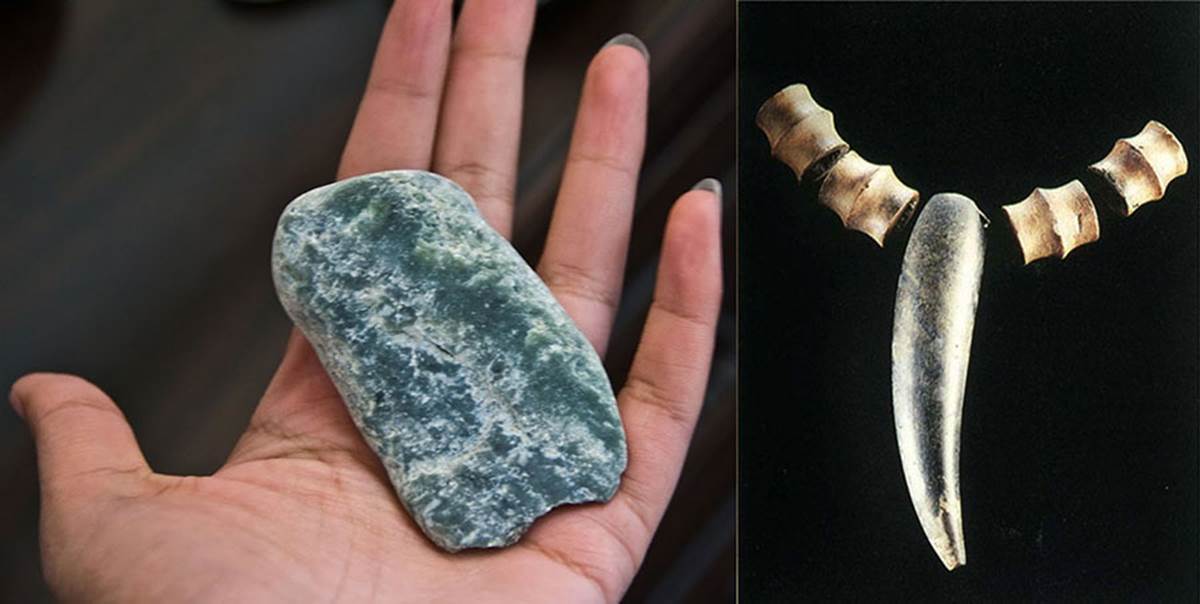
To the left is seen unworked greenstone, which can look unimpressive in its raw, unpolished state and not stand out as anything special to the inexperienced eye. To the right is seen an expertly carved and polished greenstone pendant in the shape of a tooth, accompanied by carved reels of Moa bone. This was one of the grave goods found at Wairau Bar.
There is much in Maori oral tradition to suggest that those who possessed and worked greenstone were a special, separate people who Polynesian Maori encountered upon arrival in New Zealand from Hawaiki. Oral traditions tell us that Pounamu (the Maori name for greenstone) originates with Poutini, who is looked upon as the origin or personified form of greenstone. Poutini was one of the offspring of Tangaroa, god of voyages and ocean migrations and a son of Rangi & Papa (the sky & Earth). References to Tangaroa describe him as fair-haired or having sandy-coloured hair and fair offspring (the moon maidens) and coming from a land where the leaves stayed on the trees for only half the year.
The source of greenstone was the progeny of Tangaroa and the stone itself was often associated with fish. Tangaroa, in one of his assigned roles, represented all fish. The Dominion Museum article devoted to Nature Myths, says of greenstone:
“One quaint old folklore repository of Matatua district told me that Poutini the origin of greenstone is one and the same as Poutini the star. His people are the greenstone folk, a people who descended from the heavens and dwelt at Hawaiki, but in latter times came to New Zealand. These greenstone folk were persons of importance and had many chiefs. They were attacked here and lost a number of their people, who were slain, which was a benefit to the Maori people. These slain and captured greenstone folk represented blocks of greenstone acquired by the Maori and famous greenstone artefacts. Greenstone is often alluded to as the whatu o Poutini or “stone of Poutini”, also the ika a Ngahue, or “fish of Ngahue”. One old tale speaks of greenstone having been alive, and when caught it was cooked in the oven”.
But let’s consider the logistics or possibilities of an incoming Polynesian group, who had no knowledge of jade-greenstone as a venerated or precious item and no knowledge of how to carve the incredibly hard stone, creating an ornate, expertly made, greenstone pendant so soon after arrival on these shores.
1. Are we to believe that early-era, Polynesian explorers from Wairau Bar on the East Coast travelled (as the crow flies) 180-miles (290 kilometres) into the harsh hinterland of snow-capped mountains, deep gorges and fast-flowing rivers to the sources of greenstone near Hokitika on the West Coast, saw the raw stone and immediately recognised it as precious?
2. Did they start a tradition of making the perilous journey to acquire large quantities of greenstone, for fashioning treasured ornamental objects (adzes, mere, tiki, pendants, etc.)?
3. How did they learn to carve greenstone in such a short time and with such precision, when they had no prior knowledge of how to work the incredibly hard stone?
It’s easy to logically conclude that the Wairau Bar, whale-tooth, greenstone pendant was made long before 1300 AD by people who had been in long-term residence in New Zealand, spanning at least 2000-years (refer to the Poukawa archaeological dig) before 1300AD. These were the greenstone folk or children of Poutini, who had been in residence for so long that they had explored and settled the choicest living areas of the entire country and long-since found the greenstone resources. Like the South Americans, Chinese & Celts of Europe they both venerated and knew how to fashion greenstone objects to perfection … a very difficult task. It’s estimated that carving a single greenstone mere, without metal tools, could be the life’s work of one artisan.
REPATRIATION & REBURIAL OF WAIRAU BAR SKELETONS BY RANGITANE IWI
In an article titled: A triumph of belief over science, the writer summed up the sentiments of many disappointed New Zealanders:
“Are future generations going to regret giving the remains of 53 of New Zealand’s first people dating from the thirteenth century, back to Rangitane for reburial on the Wairau Bar on 16th April? We do not know where they came from or if they left descendants. Their numbers appear to be mysteriously growing, so just who is being reburied?
Is this state sanctioned destruction of irreplaceable ancient remains linked to Waitangi Treaty settlements? The Wairau Lagoons form part of the NZ$79.6 million settlement agreement with the 4000 members of the Kurahaupo Trust signed on the 11th February, 2009.
The archaeologists undertaking the recent dig on the Wairau Bar were paid by the taxpayer to find nothing. They were paid to find reburial sites with little archaeology and any finds were a by-product. Any future research or publications have to be sanctioned by Rangitane and the data from the study of the human remains by Otago University is not going to be made available to other scientists. We may never know who or where the ancient people of Wairau Bar came from, if Rangitane choose not to tell us. Surely this is intellectual property that belongs to all the people of New Zealand?
We are giving a small group of people pursuing their own agendas, control over what we know and think about our founding people as well as access to their burial place. If the origins of the Wairau Bar people prove to be in China, Asia, India or Indonesia (even if via other Polynesian islands), surely New Zealanders from those cultures should be consulted about the reburial and have right of access to the burial site to pay their respects and conduct their own religious ceremonies? Surely scientists should have access as technologies develop to answer these questions of international interest.”
http://forums.e-democracy.org/groups/canterburyissues/messages/topic/5YkV9ZfOMdYgOe28B9qsXE
Note: In August 2005, the remains of 12, perfect-specimens-for-study skeletons, found by contractors at Manutahi farm, Taranaki, were removed from a bog urupa (cemetery) that was unknown to Maori. Under a cloak of secrecy the remains were re-interred at Manutahi Marae by kaumatua of the Ngati Pakakohe iwi. The skeletons, which even Maori agreed were not theirs, were not allowed to undergo scientific assessment.
THE POUKAWA, HAWKES BAY, PROBLEM
While our archaeologists cherry-pick much-sanitised evidence that suits the requirements of political agendas, the elephant in the room goes unnoticed and unmentioned. All our professionals need to do is return to Poukawa, Napier district, New Zealand and recommence the now long abandoned, 1960s archaeological digs of Russell Price and his teams (including renown Pedologist, W A Pullar of Soil Bureau, Whakatane). They will quickly find indisputable evidence of Moa-Hunter occupation below the signatory tephra of the Waimihia ash-band of circa 1350 BC … and from there we can get far more plausible or believable clues concerning the true epoch when Wairau Bar was first occupied.
In a Statement of Belief, leading scientists, commenting on the Poukawa findings, co-wrote the following testimonial:
'Occupation of this site has continued over a long period. The older occupation appears to have commenced prior to the commencement of the peat formation and hence also before the water level of ancient Lake Poukawa had reached its highest level. If the rate of peat formation has been substantially uniform peats commenced forming at about 'post'-glacial sea level maximum, say 4,500 years ago. The stratigraphically lowest discoveries lie below this peat and may conceivably pre-date ca 4,500 years ago'. 'The site demonstrates human occupation of this area of much greater antiquity than anything previously anticipated'.
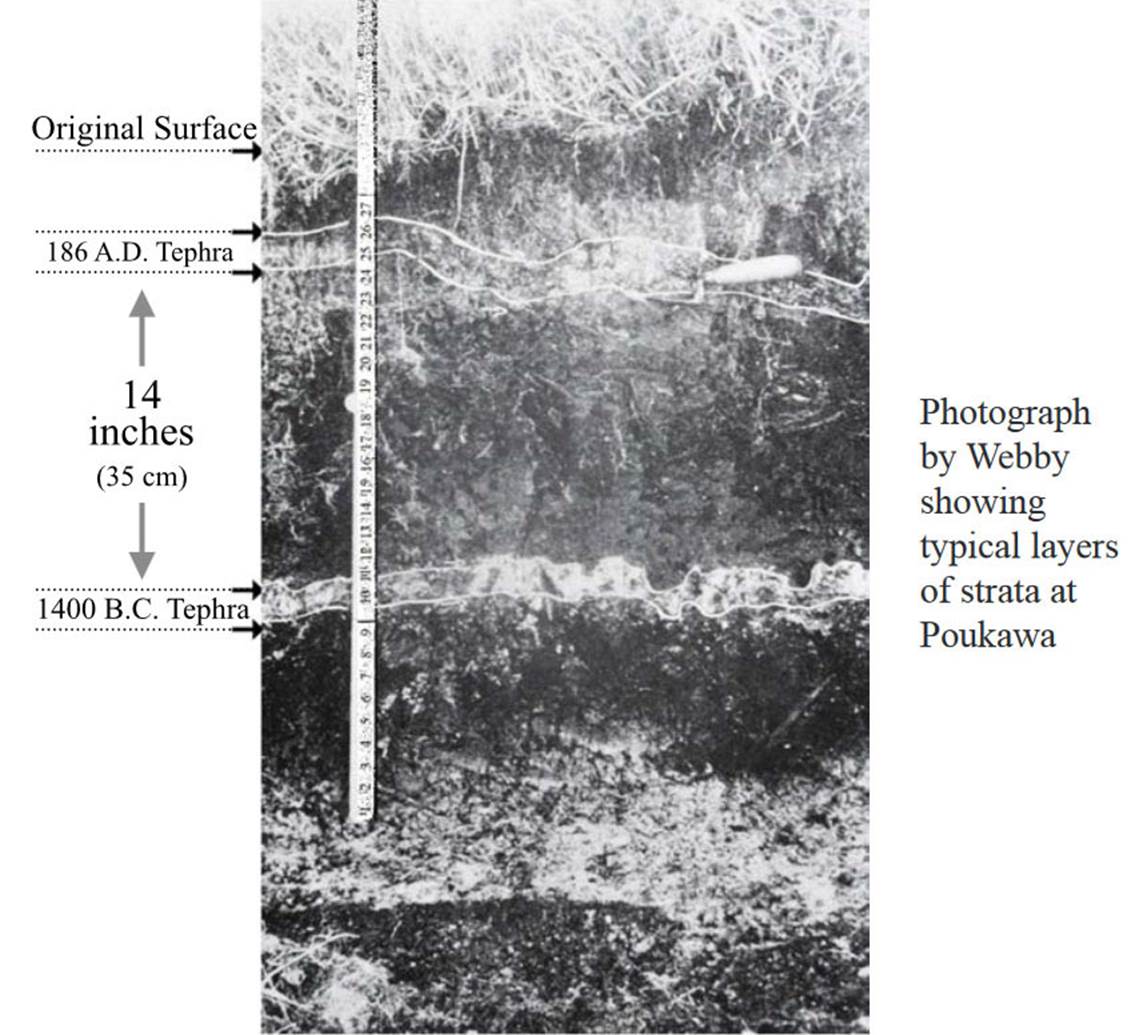
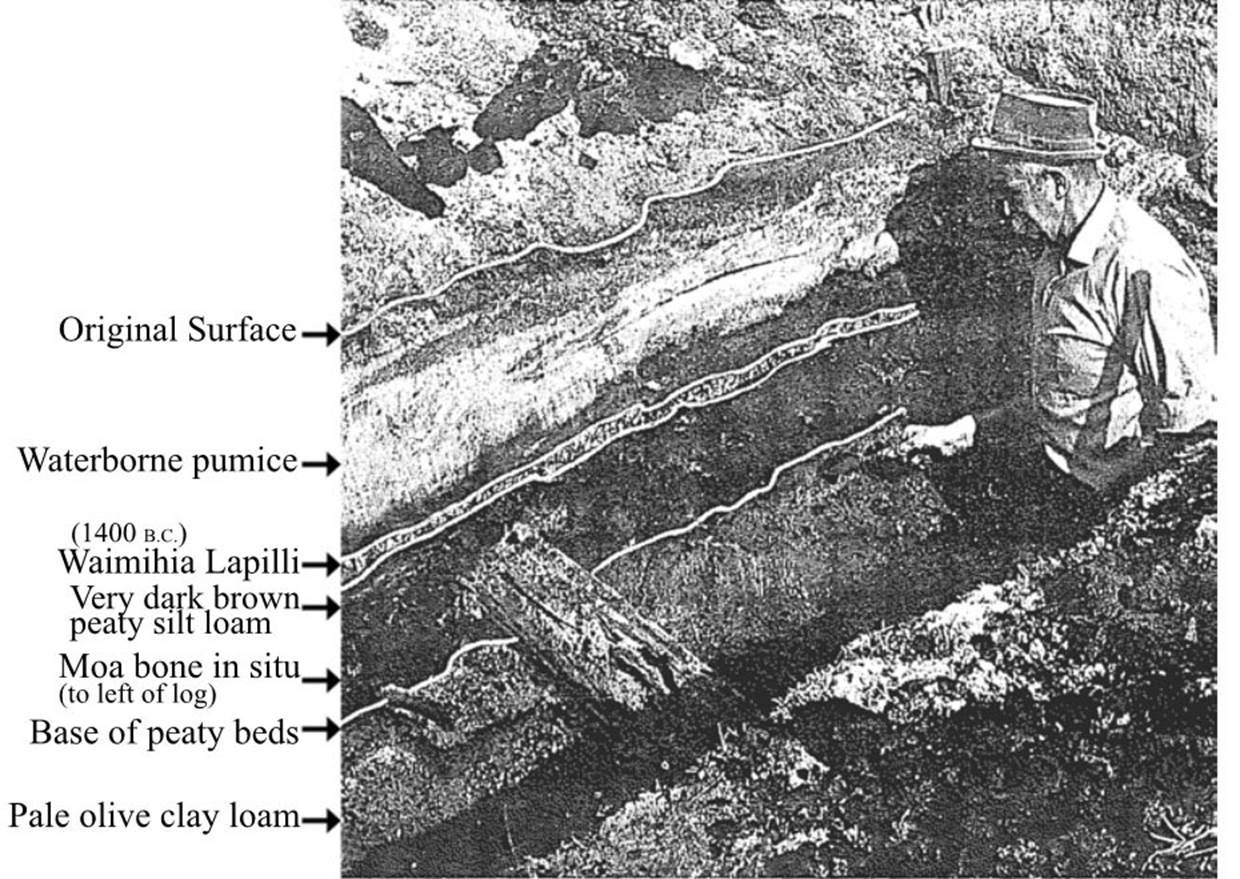
Cooked, broken and scraped Moa bones, as well as human made artefacts were found beneath the fallout tephra ash band from the circa 1350 BC Waimahia volcanic explosion.
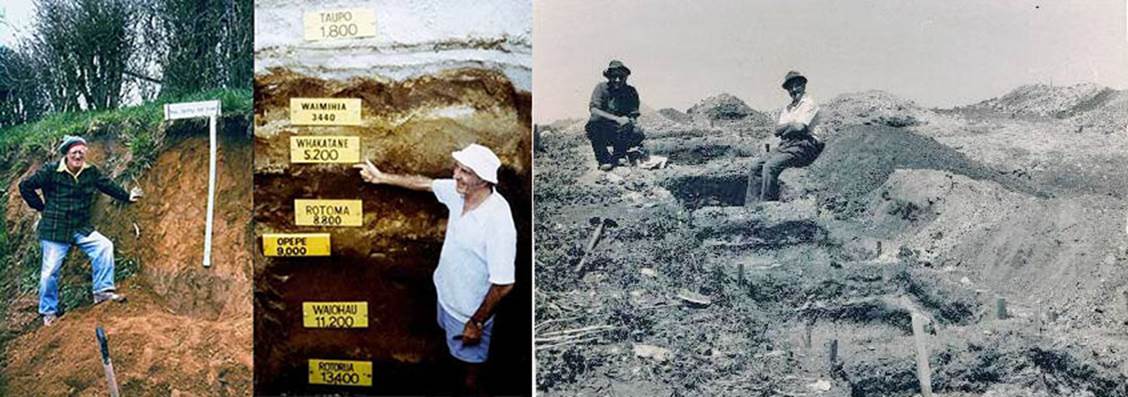
Left: Allan Pullar. Middle: Collin Vucetich (Both men worked for the DSIR Soil Bureau). Right: Russell Price & colleague at the Poukawa archaeological site.
Here are excerpts from John Tasker’s book, Chain of Evidence:
‘Leading Pedologist Alan Pullar joined the dig on 30 December 1964.’
'Pullar next turned his attention to volcanic ash bands in the ground, having come to the conclusion that they were capable of offering important stratigraphic datums to field archaeologists. The three that he singled out for particular study were the Kaharoa ash-fall of ca 1100 AD, the principle Taupo shower of ca 186 AD and the Waimihia fall of ca 1320 BC. Each showed up in the ground with their own distinctive colours and textures, and each had at one time been ejected by a volcano as an ash shower. Kaharoa from Mount Tarawera and the other two from the vicinity of Lake Taupo. They were assigned a date by the simple method of retrieving charcoal or peat samples from immediately above and below each band and dating them by the C14 method. Thus bracketing the layer between two known dates, and cementing in place a given point in time. Numerous repeats of the process enabled more precise dates to be allocated to each of the volcanic events, and the chronology of archaeological and cultural sequences in the ground could now be arrived at with greater ease and accuracy as a result.'
'Pullar took charcoal samples from above and below each of the two ashfall layers for dating purposes and these eventually confirmed his findings. He had been right, and as far as he was concerned, Price's discovery was the most astounding yet in terms of New Zealand archaeology. According to the evidence, man had been in New Zealand at least 3,300 years...he knew in his heart he was right, yet realised at the same time he had better exercise restraint when writing up his report for his fellows (NZAA, Vol 8, No1). They were an ultra-conservative lot, and would do their best to shoot him down in flames'.
'If the lower layer is indeed Waimihia lapilli' , he wrote gingerly, 'then the discovery by Price of items related to man found below the pumice band raises implications almost too daring to be true'.
'...the knocking machine swung into immediate action. The first objection concerned the placement of ash-bands. It was alleged they must have been water-borne centuries after the volcanic events and that Pullar had misread them. Nice try, but Pullar had sorted that out long ago. He was well aware of the difference between 'water-borne' and 'air-laid' (NZAA, Vol. 4, NO 2)... Under the microscope the air-laid particles were sharp and angular at the base of the band. The water-laid particles above were rounded and worn. To his expert mind there was no doubt whatever. The lower band was Waimihia and it had been air-laid 3,300 years ago. Which meant that any human cultural material found beneath it had to be at least that age'.
'These conclusions were confirmed in full when three geologists visited the site. They had come to determine whether the ash layers as found 'may have been artificially re-deposited centuries after the Taupo and Waimihia eruptions'...Wellman, Kohn and Vucetich independently identified the ash showers and agreed with Pedologist Pullar that they were indeed air-borne deposits from the Taupo eruptions, and that their original placement was as seen today. They were satisfied from the structure of the showers. And the consistency throughout the district that there could be no mistake about it'.
The knocking machine tried other tactics to discredit the work.
'One of the assertions about material recovered from below the Waimihia ash was that 'it might have fallen through the ash showers from above'. The matter was straightened out by Price himself...'The showers of ash have been undisturbed above the earliest artefacts, he said in 1966, 'and in places a concrete-like matrix lies above them, deposited by later inhabitants'...thus making it impossible for objects from an upper layer to seep down and lodge themselves in a lower layer'.
'Dr. Richard Holdaway confirms this sort of thing as well. In a 'Listener' article (Rat Revisionists', 7.12.96) he said'...'most archaeologists have never actually excavated through two feet of ash. It seals everything underneath it. You can see every last wormhole in it and you can see where there is damage to it. So if something is underneath you know it was there before the ash fell...'
'Some insisted that ancient moa bones showing evidence of human manipulation at the lowest levels of the site 'might have been deposited naturally'. They must have been kidding. Almost all were broken open to extract the marrow, most had been burned in a fire and some had cut marks on them made by a sharp stone implement. All of which indicated a heavy human involvement. 'Unless, as Price observed at the time, 'ANCIENT MOAS SPENT THEIR TIME BREAKING THEMSELVES UP AND COOKING EACH OTHER'. (Emphasis added).
'Another objection put forward was that 17th and 18th century Maori might have dug down through the ash layers to retrieve old moa bones for fashioning into tools. And in that process a certain amount of juggling occurred in the ground. Those actually present at the site laughed at this idea. Nowhere had either of the two ash mantels been pierced in this way, and since all bones concerned had been through a fire they would have been totally unsuitable for the manufacture of artefacts anyway. A third clinching point against this particular objection was that over the whole site no moa bone artefacts of any type were found. There were a lot of bone artefacts in evidence, but these were all fashioned from sea mammal, small bird or human remains'.
'None of the objections were capable of withstanding close scrutiny in the 1960s, and today they are made to look even more ridiculous by documents harking back to those days'.
'THE STATEMENT OF BELIEF'
'What almost nobody realised in the late 1960s is that a hard core of top scientists who had visited the Poukawa site were totally behind Price and Pullar. They could see the obvious. However, to openly stand beside these two would have cost them too much so they did the next best thing. A number allowed their names to be associated with a secret 'Statement of Belief', marked across the top 'RESTRICTED - NOT FOR PUBLICATION'. And because it vindicates Price and Pullar, and because the conclusions drawn go way beyond what these two could ever have envisaged, parts of it will be quoted now in such a manner as to leave the writers unidentifiable - with two exceptions. In order to demonstrate the high-level nature of the Statement it should be known that both Drs Flemming and Rafter had a hand in its composition...'
'The data Mr Price has slowly accumulated...has demonstrated that the results have to be taken seriously', the Statement began.'
'W A Pullar of Soil Bureau, Whakatane, visited the site earlier this year, examined ash layers contained within peat and collected radiocarbon samples from above and below the ash layers. The dates from these confirm his identification of the Taupo and Wamihia pumice ashes''
The controversy over 'water-laid and air-laid ash was settled in a few sentences...'
'Within the peat are two pumice layers; the lower about 1½ inches thick, has a sand-size lower half and a fine silt-size upper. In the exposure we saw it was entirely air-laid. About a foot above the rhyolite ash horizon is a second layer of course grit-sized rhyolite pumice lapilli; this is only about ¼ inch thick in the higher parts of the wedge, but is irregularly thickened lower down. In these lower parts the bulk of the lapilli are rounded and the thickening is clearly due to transport of lapilli by water, perhaps lake water. In the higher parts the lapilli are angular and occur with sand and dust grade particles and is clearly air-laid although continuous with the water-laid part'.
'A series of Post holes at all levels also spoke eloquently to the scientists. Speaking of one such hole the Statement says that...'
'The post was ca 4" in diameter, had rotted off and the hole then infilled before the Taupo ash-fall...Similar post holes are reported below the Waimihia ash with the ash continuous across the top...The post hole we saw has every appearance of being undisturbed, and convincingly demonstrates human occupation of the site prior to the Taupo shower...The discoveries of artefacts and ovens...below one or other of the ash showers give a similar demonstration'.
'After discussing a likely geological history of the area the Statement gets straight into conclusions...'
'Occupation of this site has continued over a long period. The older occupation appears to have commenced prior to the commencement of the peat formation and hence also before the water level of ancient Lake Poukawa had reached its highest level. If the rate of peat formation has been substantially uniform peats commenced forming at about 'post'-glacial sea level maximum, say 4,500 years ago. The stratigraphically lowest discoveries lie below this peat and may conceivably pre-date ca 4,500 years ago'. 'The site demonstrates human occupation of this area of much greater antiquity than anything previously anticipated'.
'It does not yet, however, demonstrate anything about the ethnological relationships of the earlier inhabitants and the later Maoris. Although the stratigraphically lowest material is all of a flaked nature, artefacts of this type are cosmopolitan and persisted in the Neolithic cultures, so do not necessarily indicate a Palaeolithic culture...'
'This is a most interesting document, its chief significance being that four pre-eminent scientists of the day saw fit to formalise their concurred view of the implications of Price's work at Poukawa. There are criticisms of course. And even charges of forgery against the paper. But these charges are baseless and cannot be sustained'.
'According to Price's biographer, Bevan Greenslade...the papers key is 'slowly accumulated'. It indicates patience and care, and a reserve difficult to falsify. Pullar's fortuitous involvement is also commented upon. This ground-breaking geologist was experienced and independent, and it was good to have a reliable bald statement asserting positive, unconditional dated identification of Waimihia and Taupo ash tephra. On the subject of post-holes, scientists of this calibre saying words such as '...convincingly demonstrates human occupation of the site prior to the Taupo shower' is pretty staunch collateral support for Price's own ideas. Such words lifted Price out of the 'misguided or speculative amateur enthusiast' category'.
Enter Dr. Bruce Mc Fadgen and his team, made up of members of the Victoria University Geological Society and the Wellington Archaeological Society.
'The team dug in an area already dealt with by Price and in his report in the 'Journal of the Royal Society of New Zealand', (Vol. 9, No. 3, 1979, pp 375- 382) McFadgen proceeded to demolish all Price's claims and to make it difficult for anyone else to stand alongside the beleaguered farmer and still retain his or her credibility'.
'Thus all Price's post holes became 'root channels of old trees'. Disking of the area in the past mixed introduced snails and pig bones with extinct heron and notornis remains, fooling everyone in the process. Tree roots made the 'file marks' noted on some old bones. After the land was raised by the 1931 earthquake and the peat began to dry out, it cracked, and allowed surface material to fall down to sub-ash levels - in every case. The shrinking ground was also responsible for all broken bird bones as well. It was all too pat'.
'Mc Fadgen's conclusion was that 'because the peat is cracked, and things have fallen down the cracks, and because the site has been bulldozed and disked, and artefacts have been disturbed, the Poukawa site does not provide evidence for the antiquity of man in New Zealand, and is extremely misleading'.
He further stated that the site 'was probably occupied between 150 and 300 years ago' and 'there is no evidence for human occupation before the Taupo pumice eruption'.
'Tutored ones who previously wavered, now largely embraced the 'new light' provided by the team, while the public at large - or at least the members of the public interested in such things - jumped the opposite way, taking the view that McFadgen's simplistic dismissal of claims made for Poukawa were a 'jack-up', that he had approached the task of 'dealing with' Poukawa with his mind already made up, and that his conclusions ran counter to all previous indications from the site'.
See: Chain of Evidence, pp. 138 - 155.
To see undisputable results of very ancient human occupation of Poukawa, New Zealand, go to the 3 links below and magnify the C14 sample figures for clear reading.
http://celticnz.co.nz/Kaiwhakaruaki/Letter1.jpg
http://celticnz.co.nz/Kaiwhakaruaki/Carbondating2.jpg
http://celticnz.co.nz/Kaiwhakaruaki/Carbondating3.jpg
Continue






